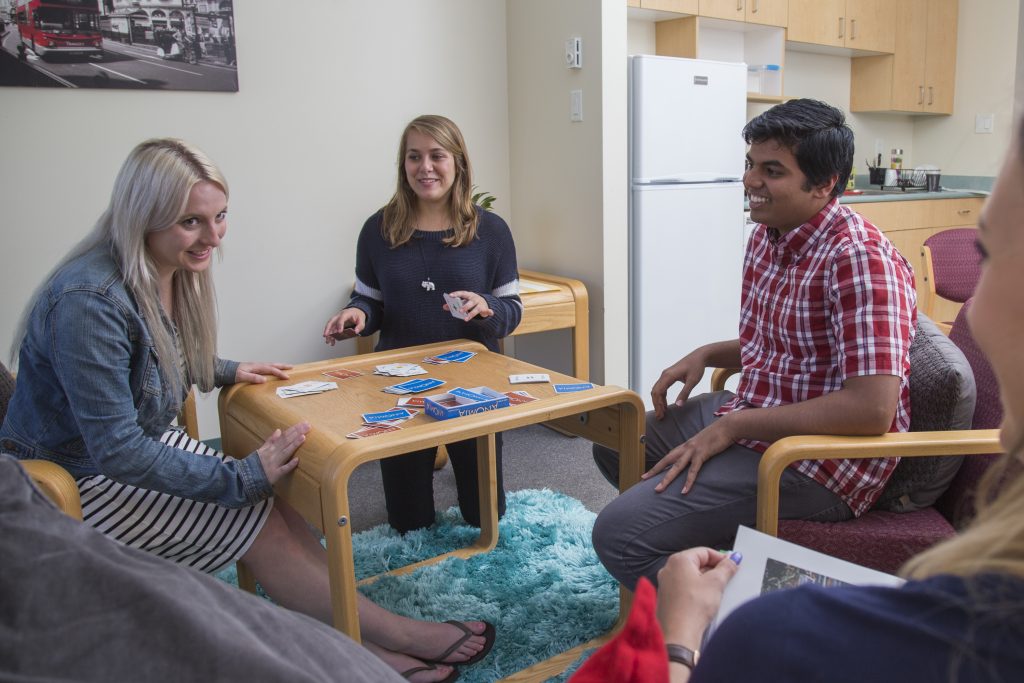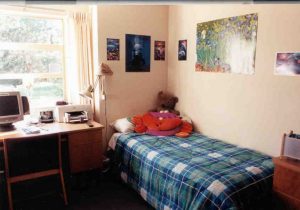Should you live in a Dorm or a Cluster House?
 I have had the privilege of living in both a Cluster unit and in a traditional dorm, so I know everything there is to know about each of these housing types and the pros and cons associated with living there.
I have had the privilege of living in both a Cluster unit and in a traditional dorm, so I know everything there is to know about each of these housing types and the pros and cons associated with living there.
Below I have laid out some important things to consider when you are deciding which housing type would best fit with your lifestyle.
While it is not guaranteed that you will get your preferred housing type, your input is considered during the assignment process. By learning about residence before submitting your housing application, hopefully you will be able to assure that you are making the right choice for housing.
Traditional style dormitory buildings

Here is a photo of my dorm room in the newest residence, Building 1.
At UVic there are currently 21 different traditional style dormitory buildings with another in the process of being constructed that will be open for move-in for September 2023.
Each resident who is selected to live in a traditional dorm building is assigned a single or double occupancy dorm. If you’re a first-year guarantee or deferral student, you’ll most likely be assigned to one of these rooms.
Single dorms come with a single twin extra long bed, a closet/dresser and a desk and chair. A double dorm comes with two single twin extra long beds, two closets/dressers and a shared desk with chairs, or two separate desks with chairs.
On each floor there are several single occupancy bathrooms and shower rooms that are shared by all the residents who live there. There are also several community lounges throughout the building that come with a microwave and sink and a television with a seating area. These are communal areas for students to hang out with friends and study with their peers.
There is also a shared laundry room which is typically located in the basement. Residents have access to laundry by downloading an app and loading money onto it or purchasing a laundry card at the front desk.
All residence dorm buildings are co-ed, meaning they are not segregated by floor for gender. It is also important to mention that each residence building on campus slightly varies in its layout as they were built at different times.
Cluster townhouse or apartment style residence
The cluster neighbourhood is made up of 121 apartment style units and townhouses. While the layout differs depending on if you are assigned to an apartment style unit or townhouse, each unit has the same facilities. *For September 2023, Cluster housing is prioritized for upper-year undergraduate students.

Cluster neighbourhood
Each unit is made up of four bedrooms, two shared bathrooms, a living room and a kitchen.
The bedrooms are equipped with the same furnishings as the traditional style dorms.
In the kitchen there are two fridges, a stove, a sink, a garbage and recycling, and adequate counter space for cooking. There are also cupboards, drawers, and storage closets. In between the kitchen and living room is a dining table with four chairs.
The living room has chairs, a couch and a coffee table. Unlike the community lounges in the dormitory buildings, the living rooms in the Cluster units do not come with a television. If you want to have a movie night with your roommates one of you will have to bring your own TV from home.
The Cluster units also come with access to an outside storage unit where you can put a bike or sports equipment.
There are two laundry communal laundry rooms located in the Cluster neighbourhood and having access to these works the same way as it does in traditional dormitory buildings.
Finally, Cluster units are single gender or co-ed depending on your personal preference and who you feel comfortable sharing a house with.
Things to consider when you are filling out your housing application
1. Food
One of the main things you want to consider when selecting which type of housing you want to live in is food.
When you live in a dorm you do not have access to kitchen facilities so you are automatically placed on the meal plan. The meal plan allows you to eat at The Cove dinning facility or the other food outlets on campus which includes; Mystic Market, Biblio Cafe, Sci Cafe, Art’s Place, Mac’s or Nibbles and Bytes.
If you are someone who is too lazy to cook every meal (no judgment, I get it) than this may be the best option for you. While getting access to a wide variety of food options without the effort of having to cook can be a huge bonus for some; for others it can cause a lot of stress.
For someone who has multiple food allergies or intolerances, or for a picky/selective eater, eating at the food outlets on campus can be rather challenging. In this case living in a Cluster unit with access to a kitchen might be the best option for you. This way you can get your own groceries and cook and prepare your own meals.
If you are a student who has specialized food requirements that would not allow you to eat at the dining hall, then you can submit a priority housing consideration form with a note from your doctor to ensure that you get placed in a Cluster unit.
2. Community
A pro of living in a dorm is the community aspect. When you live on a floor with a group of other students who are all sharing the same common spaces, you quickly get to know one another and feel a sense of connection to the people around you.

Cluster living room
When you are a first-year student who is just getting used to the University setting, having others who are in the same boat can feel very comforting. This sense of community is heightened by the events that are hosted by the Community Leaders for the residents.
These events take place a couple times a month and can range from a movie night in the lounge to an outdoor event. In a Cluster unit you will be regularly interacting with your roommates, but it requires a bit more effort to find community outside of your unit.
There are Community Leaders who host events for Cluster residents, but since there is no communal lounge these events take place in multipurpose rooms or outside.
3. Introverted versus Extroverted
 I consider myself to be slightly introverted so I found that living in a dorm was not the best fit for me.
I consider myself to be slightly introverted so I found that living in a dorm was not the best fit for me.
When you live in a traditional residence there are constantly people in the hallways, and shared spaces, so the only place where you are ever truly alone is in your room.
Alternatively, when you live in a Cluster unit the only other people that you are interacting with on a daily basis are your three other roommates who share the common spaces. But if your roommates have a lot of friends and enjoy hosting events, then you might find yourself running into many more people.
Its important to communicate your needs and personal boundaries with your roommates so that you can all feel comfortable in your shared living space.
4. Socializing
If you love to spend your weekend nights partying, then I would recommend living in the Cluster neighbourhood. Having access to a kitchen and living room gives you the opportunity to host get togethers for you and your friends. But it is important to get permission from your roommates beforehand and remember to be respectful and abide by the community living standards.
If your ideal weekend is spending a night by yourself catching up on sleep or self care, then I would recommend living in a traditional style dorm building.
If you want to completely avoid noises and people then you should consider signing up to live on a quiet floor. There are several quiet Cluster units on campus and each residence building typically has one quiet floor.
These are for students who want to keep their head down and study, and not participate in lively social activities. There are also certain Cluster units and residence building floors that are ‘substance free’ communities. While all residents living on campus must abide by legal smoking and drinking age and not cause public disturbances, there are communities that are strictly sober.
5. Final considerations
Finally, it is important to remember that Cluster units are typically reserved for second, third and fourth year students, while dorms are reserved for first-year students.
However, this does not always end up being the case. Whatever housing type you end up in you should try your best to make it feel like home and make an effort to step outside your comfort zone as you adapt to your new environment. As someone who has lived in both types of housing there are things about each that I like, and things that I wish were a little different. But ultimately, I have enjoyed my time spent living on campus, and I’m sure you will too!







